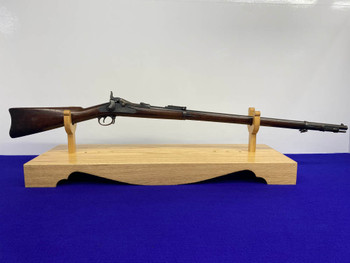Description
Item Description
Bryant Ridge Co. is pleased to present this outstanding trapdoor single-shot rifle today for a penny-start auction, this is the Springfield Armory Model 1870!
SPECIFICATIONS:
Manufacturer: Springfield Armory
Model: 1870
Serial: 24476
Date of Manufacture: 1870-1873
Caliber: .50-70
Finish: In The White
Barrel Length: 32 5/8"
Optics/Sights: Blade Front with Flip-Up Rear
Stock/Grips: Smooth Walnut
Action: Trapdoor / Single-Shot
Markings: Standard / The left side of the lockplate is stamped and dated “1864”, along with an Eagle and “U.S. Springfield”. The top of the breechblock is stamped “1870”. The top of the buttplate is stamped “U.S.”.
Bryant Ridge's Analysis:
During the U.S. Civil War, the advantages of breech-loading rifles became increasingly apparent. The standard infantry arm of the conflict—the rifled musket—could generally be fired at a rate of only two to three rounds per minute, and soldiers had to reload while standing, exposing themselves to enemy fire. By contrast, breech-loading arms such as the Sharps and Spencer carbines, though issued in limited numbers, could be fired much more rapidly—up to eight to ten rounds per minute in skilled hands—and reloaded from a prone or covered position, reducing vulnerability. As the war drew to a close, the U.S. Ordnance Department began exploring how best to bring this firepower advantage into regular service. At Springfield Armory, Master Armorer Erskine S. Allin developed a simple “trapdoor” breech mechanism that allowed existing muzzle-loaders to be converted into breechloaders. His design was attractive to the Army for its practicality: the huge stockpile of Springfield Model 1863 muskets could be repurposed for only about $5 per rifle, far less than the cost of building new weapons. The first version, the Springfield Model 1865, introduced a rimfire .58 cartridge and an intricate breech system, but its fragile extractor and overly complex mechanism quickly proved unsuited to hard service.
Model: 1870
Serial: 24476
Date of Manufacture: 1870-1873
Caliber: .50-70
Finish: In The White
Barrel Length: 32 5/8"
Optics/Sights: Blade Front with Flip-Up Rear
Stock/Grips: Smooth Walnut
Action: Trapdoor / Single-Shot
Markings: Standard / The left side of the lockplate is stamped and dated “1864”, along with an Eagle and “U.S. Springfield”. The top of the breechblock is stamped “1870”. The top of the buttplate is stamped “U.S.”.
Bryant Ridge's Analysis:
During the U.S. Civil War, the advantages of breech-loading rifles became increasingly apparent. The standard infantry arm of the conflict—the rifled musket—could generally be fired at a rate of only two to three rounds per minute, and soldiers had to reload while standing, exposing themselves to enemy fire. By contrast, breech-loading arms such as the Sharps and Spencer carbines, though issued in limited numbers, could be fired much more rapidly—up to eight to ten rounds per minute in skilled hands—and reloaded from a prone or covered position, reducing vulnerability. As the war drew to a close, the U.S. Ordnance Department began exploring how best to bring this firepower advantage into regular service. At Springfield Armory, Master Armorer Erskine S. Allin developed a simple “trapdoor” breech mechanism that allowed existing muzzle-loaders to be converted into breechloaders. His design was attractive to the Army for its practicality: the huge stockpile of Springfield Model 1863 muskets could be repurposed for only about $5 per rifle, far less than the cost of building new weapons. The first version, the Springfield Model 1865, introduced a rimfire .58 cartridge and an intricate breech system, but its fragile extractor and overly complex mechanism quickly proved unsuited to hard service.
The Model 1866 represented a far more reliable refinement. Its barrel was altered to accept the new .50-70 Government centerfire cartridge, which delivered greater range and stopping power, while the breechblock was simplified and strengthened. Although the extractor was still imperfect, it was sturdier than before, and the rifle as a whole held up better under field use. Around 52,000 were produced, mostly conversions, and they quickly saw combat on the frontier. The Springfield Model 1870 carried the system another step forward. Unlike the 1866, which leaned heavily on relined barrels, the 1870 generally featured newly manufactured barrels and stronger construction overall. At the same time, it still reused older parts when practical: many rifles incorporated lockplates from older 1863 rifles, along with other leftover components from Civil War muskets, reflecting the Army’s ongoing effort to economize. The receiver was slightly shortened, and two versions were made with different rear sight placements—first set close to the receiver, then shifted forward for improved usability.
Approximately 11,500 rifles were manufactured between 1870 and 1873, along with a small number of roughly 360 carbines for mounted service. Like its predecessor, it remained chambered in .50-70 Government, offering dependable performance but marking more of a transition than a final solution. In hindsight, the Springfield Models 1865, 1866, 1868, and 1870 were not merely stopgaps but essential stepping stones to the iconic Springfield Armory Model 1873. They bridged the gap between the Civil War’s muzzle-loading muskets and the definitive breech-loading rifles of the late 19th century. By combining economical conversions with gradually improved designs, they provided the U.S. Army a practical path toward modernization.
Return Policy:
We gladly offer a 3 day unfired inspection policy from the time that the firearm is delivered to your FFL. Refunds are available for all qualifying orders.
Shipping Details
Handgun Standard Shipping with Insurance $50.00
Long Gun Standard Shipping with Insurance $70.00
Any orders placed with magazines that are not compliant with your state, county, or city regulations will not ship with your order.
We strive to ship orders within the close of the following business day after payment and documentation is received.
Payment Details
We accept all forms of Payment including Personal Check, Business Check, PO Money Orders, Certified Check, Etc.
Please note we place a 7 business day hold on shipment, for all non-certified payments.
Payment MUST be received within 14 days.
Return Policy
We gladly offer a 3 day unfired inspection policy from the time that the firearm is delivered to your FFL. Refunds are available for all qualifying orders.
Additional Details
Our #1 priority is customer satisfaction. We want to build a lasting trust in the relationship with our customers, so that you will always look to us for all your firearms needs. If you have any issues with your transactions please contact us, and we will work with you to resolve any issues you may have. We greatly appreciate your trust in us and we look forward to fulfilling all your future firearm needs.
Bryant Ridge also reserves the right to cancel any sales that may occur while gunbroker.com is experiencing technical issues that affects the entire site or a complete site outage, within an hour of the auction ending.
We have an amazing inventory of classic and collector firearms that we are adding to Gunbroker daily. Stay up to date on all of our latest auction by adding us to your favorite sellers list.




















